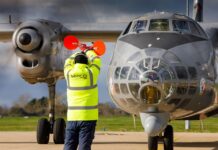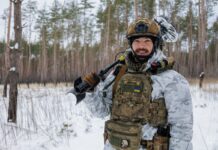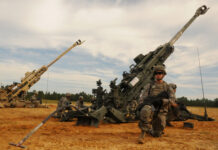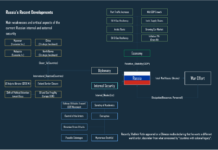Kiev
More than six years since the beginning of the war in Ukraine’s eastern Donbas region – and after what is in excess of 13,000 deaths on both sides – it is possible to come to some conclusions about the Russian advantages in the conflict. While the fighting has not proceeded along the lines of what is normally thought of as a conventional military operation, what falls out of the years of this war, which is often kept at a low boil so as to not prompt the entrance of other nations into the fight, are some distinct indicators of how the Russians are preparing for future engagements.
First of all, there is truth in the observation that Russia has been sending its personnel into the Donbas almost as a kind of an initial training ground before they are then deployed elsewhere. Often those personnel are then sent on into Syria for additional combat experience. This has created the false impression that there is some common, “cookie cutter” model of operations that the Russian military is engaged in being practised in parallel in both conflicts.

On the contrary, the Russian operations in Ukraine and Syria – as well as other operations in previous conflicts like the invasion of Georgia – show that Moscow’s military prosecutes conflicts under distinctly different sets of objectives and divergent approaches.
Therefore, it is not a valid approach to be looking for an A to Z textbook that one can expect Russian military units to follow – a kind of template that they would utilise in any given conflict. It is also equally inaccurate to project that current-day Russian warfare would be based on the doctrinal approaches that dominated military thinking during the Soviet period.
There is an argument to be made that the most recent conflicts have featured a substantial increase in the use of non-kinetic methodologies and what have been referred to as “hybrid” approaches to overcoming an adversary, but these again cannot be codified into a pre-programmed set of options that are always brought to bear.
Supporting Moscow’s Narrative
The primary driver for the campaign in the Donbas not to follow any pre-programmed Russian operations plan was a set of political considerations. These were issues that supersede normal battlefield imperatives that dictate combat units being committed in the most effective or expeditious manner. Bringing Russian military power into the fight, in this case, has other imperatives besides the goal of achieving a set of military objectives.
Moscow’s initial narrative was that the outbreak of hostilities were solely the product of a pro-Russian separatist movement in which there was no Russian involvement – and that President Vladimir Putin’s “Little Green Men” did not even exist. In the initial phases of the conflict this called for a minimal and at times even obscured Russian presence on the battlefield. Instead, the plan called for handing over large quantities of weapons platforms delivered from Russia into the separatists’ hands.
The almost overnight acquisition of such a considerable fleet of military equipment was “officially” explained by Moscow initially as the spoils of war in a rather feeble attempt to once again hide Russia’s intervention in the conflict. This narrative was that these vehicles fell into separatist hands after a force of these pro-Russian units successfully attacked and overran a Ukrainian military armoured vehicle base in Artemivsk. This Ukrainian installation contained almost 800 types of different armoured vehicles, including an estimated 250 tanks, but most of these were in the process of being refurbished and were not ready for combat.
Despite the reality that obtaining any significant quantity of useable armour that could be deployed in battle from what is essentially a repair and maintenance base is impossible, the truth is that the separatist formations had not actually even taken the base from the Ukrainian military. During the spring and on into the summer 2014, separatist units tried to take over this installation in five different assaults and were unsuccessful on each attempt.
The source of the separatist armoured force has instead come across the border in one long column of Russian military equipment after another. These vehicles, which had their identification markings and traditional vehicle numbering removed in an attempt to mask their origins, made regular transfers of ownership across into Ukraine at border crossings where Russian units control these movements.
The volume of equipment and frequency of these crossings has been such that mass transport of such an amount of equipment and weapons can neither be camouflaged nor concealed. Attempts to move them in smaller numbers or engage in any other subterfuge would disrupt the armaments supply tempo for the separatist groups fighting on behalf of the Russian Federation. This battlefield imperative has revealed that Russian-origin vehicles constitute the majority of the materiel being deployed against the Ukrainian military.

Russian Armour: How It Is Being Supplied
Re-supply of armoured units with new platforms was observed in August 2018 by an Unmanned Aerial Vehicle (UAV) operated by the OSCE Observer Mission, which reported sighting two such columns in the occupied regions of the Donbas. One of these columns entered Ukraine in Manych, 70 kilometres from the regional capital of Donetsk, and a second column was moving in the opposite direction and crossed back over into Russia.
These sightings by the OSCE confirmed three realities that the Ukrainian military had long been trying to make the international community recognise.
One is the simple fact that the some of the latest and most effective weaponry in the Russian arsenal has been supplied by Russia. Moreover, the commander of the Ukrainian forces in the Donbas has stated that these crossings are taking place “constantly” and that these columns of armour and heavy-laden lorries are the tell-tale signs of a Russian incursion.
(Ukraine has informed the international community about these crossing on numerous occasions but has not been able to gain official recognition from certain states that this activity is taking place until the OSCE sighted these transfers. Confirmation by the OSCE was considered to be a major step in receiving official recognition of this activity.)
A second issue is that the separatists operating these vehicles had to have been extensively trained by the Russians. A Colonel in command of the Ukrainian 93rd Brigade stated “yesterday’s miners can’t just find a tank in their mines and instantly learn how to drive it without special training.” Many of the locals from the separatist units are former coal miners, which is one of the primary industries in the Donbas, and they continue to receive Russian training.
Finally, while personnel being trained by the Russians have learned how to operate Russian armoured vehicles, there apparently has been no parallel activity to train them in maintaining them.
Ukraine’s intelligence service has reported that since the beginning of 2018, more than 40 armoured fighting vehicles have been delivered to Ukrainian separatists as replacements for broken down hardware. The movement of columns out of Ukraine and back into Russia is for disabled vehicles that require maintenance or other servicing – which could not be repaired on the territory of the occupied territories in the Donbas.
Former NATO intelligence officers who spoke to ESD stated that Russian intervention in the Donbas was not well thought through. This can be seen first of all by the “poor performance of the units in battle and their very low levels of leadership and discipline.”
The other failure, as noted above, was the lack of preparation of the separatists in maintaining the equipment being supplied to them by Moscow.
In the very beginning in 2014, said one former defence attaché who was deployed in the region, “the logistics for these armoured vehicles were dire at best. You would see tanks and IFVs supplied by the Russians – but then no servicing vehicles at all coming up with them. Supporting infantry and other personnel would be trailing along behind them in regular civilian vehicles – private automobiles and ordinary delivery vans. So, the first time there was a need for any serious servicing of these vehicles it was time to drag them back across the border to Russia.”
Russian Units in The Donbas
The Ukrainian “statelets,” as they are known, that Moscow has established in the Donbas are the Donetsk People’s Republic (DNR) and the Lugansk People’s Republic (LNR), the two regional capital cities of eastern Ukraine. Multiple analysts looking at the current military situation say that the continuous traffic of military hardware being shipped out of Russia into these occupied zones has created significant armoured formations in both “republics.”.
According to Ukrainian intelligence reports, these pro-Russian enclaves now have in their arsenal 475 tanks, about 1000 armoured fighting vehicles, over 700 artillery systems and more than 200 multiple launch rocket systems. These platforms are almost entirely Soviet/Russian-design equipment which were passed to these “military corps” of DNR and LPR groupings from bases in Russia.
But while the separatist formations in Ukraine now feature a high-profile presence of Russian military hardware there has still been a considerable effort to minimise the presence of actual Russian military personnel.
Russian forces have also been equipped with progressively more advanced air defence systems and some of the most advanced electronic warfare equipment in Moscow’s arsenal. Both of these assets were put in place as force protection to keep the Ukrainian air force from being able to strike Russian regular military units, many of which are composed of “contract soldiers” – those serving under agreements for pay scales comparable to the private sector, rather than units of conscripts.
In large measure, Russian regular formations were only used in combat against major Ukrainian-held objectives and supported by main battle tanks and IFVs and equipped with modern, encrypted communications systems and reconnaissance drones.
EW: What Gives Russian Armour the Edge in the Donbas

Ukrainian units and intelligence services have sighted and verified the use of 44 different kinds of weapons being employed in the Donbas – all of which could only have come from the territory of the Russian Federation as they were never in the Ukrainian inventory.
These range from trucks and tanks, to more advanced systems that are the latest iterations of post-Soviet-era designs. For example: the PANTSIR-S1 air defence system – an anti-aircraft platform armed with two paired 30 mm cannons, which was accepted into service into the Russian armed forces only in 2012: Ukraine has never acquired this weapon system. In the same category is the T-72B3 tank, which is the main battle tank of the Russian army for those units not yet upgraded to the T-90. It differs from other tanks of similar configuration in that it has a new fire control system fitted with a Belarusian SOSNA-U gunsight. Introduced in Russia in 2011, it was never delivered to Ukraine. Use by the Russians of this tank in the Donbas was confirmed when one of them was captured in Ilovaisk by Ukrainian troops.
Another armoured system used in the Donbas is the BPM-97, which is also a Russian-only armoured 4 x 4 MRAP vehicle, with some specific features that differentiate it from other platforms of its kind. It exists in several configurations, some of them used by special forces of the Russian Federation since 2009, but has never been delivered to Ukraine in any military configuration. The well-known mercenary corporation ChVK (Частная Военная Компания) or the private military company the Wagner Group, has used the vehicle, which was originally designed for the Border Guards Service in Russia due to its smaller size and manoeuvrability. Wagner Group took certain measures to obscure their employment of the BPM-97 in Ukraine during the battle for Debaltseve. (The mercenary company also made use of the BPM-97 during their operations in Syria.)
But it is not just having these more advanced platforms that gives the Russians and their surrogates the edge over Ukrainian armed forces in the Donbas. At the beginning of the conflict, the Ukrainian military found itself at an disadvantage due to the advanced reactive armour technology and active anti-ATGM protection fitted to Russian vehicles. In the early phases of the Donbas war Ukraine’s military had no anti-tank missiles with a tandem warhead that could penetrate the armour plating of the T-90 and advanced T-72 models.
This vulnerability was eliminated when units in the Donbas began receiving the first new-design SKIF ATGM from the Luch Design Bureau in Kiev. Ukraine had also requested that it be permitted to acquire the US-made Raytheon FGM-148 JAVELIN ATGM, but the purchase was blocked on multiple occasions by the Obama White House. After the Trump Administration took office in January 2017 this policy was reversed and in 2018 Ukraine’s military was given the option to procure the missile.
In the meantime, the effective use of armour by the Russians in the Donbas has been augmented by the expanding commitment of some of their most modern electronic warfare (EW) systems. Confirmed in numerous reports by both Ukraine’s intelligence services and the OSCE Monitoring Mission, Moscow has equipped separatist units from Donbas with the KRASUKHA-2 1L269 jammer, the Bylina RB-109A REPELLENT-1 and the LEYER-3 RB-3418.
These are some of the latest Russian EW systems and they only began to be deployed with combat units after 2010. As with the advanced armoured vehicles discussed above they have never been possessed by the Ukrainian army. The RB-3418 has also been used in the field in Donbas operations in conjunction with the Russian-made ORLAN-10 UAV, which has a considerable loiter capability of up 16 hours and operates at distances in excess of 100 km.
Aside from being able to use the considerable Russian EW assets to essentially blind the Ukrainian military’s sensors and constantly disrupt their situational awareness, the ORLAN-10 allows separatist units to pinpoint the location of Ukraine units, which accounts for the increasing lethality of Russian artillery and rocket attacks.
A Frozen Conflict
More than a year ago, a senior political leader in the Donbas gave an assessment of the conflict in the more recent past, stating “when the first casualties started, nobody believed it would last so long. The worst thing is, that people have gotten used to the conflict … for instance, they can tell by the sound of flying objects what kind of weapon it is and even its calibre. Everybody’s pretty tired of this. People who live along the contact line don’t care who’s president [of Ukraine], they just want the war to stop,” he said.
Two elements keep the fight at a stalemate in which one side cannot displace the other. One is that while the commitment of armour makes a difference – in both numbers and the modernity of the tanks themselves – it is not enough by itself. American advocates of heavy armour forces have analysed the loss by the Ukrainians at the battle of Debaltseve as validation that “tanks still matter.”
But the Debaltseve fight shows once again that while combat vehicles must have the combat potential needed in the present day, armour still has to be integrated effectively with infantry, and artillery into a combined arms order of battle. Both sides have been learning these lessons, but Ukraine still lacks the numbers of personnel and equipment in sufficient numbers to be able to re-take the entirety of the Donbas.
At the same time, the separatist formations suffer from what could be called the lack of a legitimate motivation to prosecute the war. The separatists are not fighting for their own nation, but instead for the interests of Moscow. Russian military units support them and at times do all of the heavy lifting for them, but they will not and cannot fight the entire conflict for them.
Lt. Gen Sergei Nayev, the Ukrainian commander in Donbas, told the daily Golos Ukrainy in 2019 that “Russian mercenaries who are shelling peaceful cities and villages, killing women, children and old people have no right to call themselves servicemen. To be a serviceman means to be a person of honor and courage. To be a true serviceman means to be ready to defend one’s native land to the last breath. He who craves for a foreign peaceful land is a marauder and a criminal rather than a serviceman.”
As long as the conflict is characterised by this kind of a standoff there seems little chance for it to come to an end.
Reuben F. Johnson is a 30-year veteran of reporting on the defence sector and analysing political-military affairs in the former USSR and East- ern Europe, the PRC and SE Asia
and Latin America. His articles have appeared frequently in US, European and Asian defence and public affairs journals and he is also a long-time consultant to the Department of Defense. He is based in Kiev, Ukraine where hs has covered both the 2004- 2005 Orange Revolution and the 2013-2014 Maidan Revolution.











